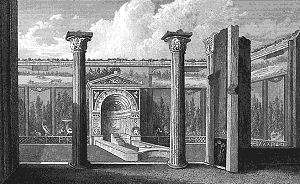Plate LIII - Fountain of shells
|
In Plate LIII is exhibited the garden, pseudo-garden or painted wall, and part of the inner portico of a dwelling, which, on account of the fountain here also represented, caused a greater sensation at Naples than any previous discovery had created. The house was found in the month of June, 1820, and the excavation terminated in October. |
The arch or alcove of the fountain is, on the spot, termed
the grotto, and that is the name by which, at present,
it may be found. The high wall was, at the time of its
excavation, perfect ; and this drawing is, probably, now the
only record of its existence, the author having been
fortunate enough to copy it before the painting fell. Had it
gone no higher than the first row of panels of alternate
yellow and blue, the effect would have been very pleasing ;
but the upper line of pictures, one of which seemed to have
represented a boar-hunt, destroyed the illusion. In the
panels were several birds painted with great spirit, some of
which were killing reptiles, and a curious collection of
garden rails of several forms, which are here
represented.
The fountain itself is a great curiosity, though not quite an
object of taste, being nothing more in its form than what is
common in the courtyard of every house in Rome. It is,
however, incrusted with mosaic of a blue colour and vitreous
substance, and the borders are formed of real shells from the
sea-shore, which seem, almost miraculously, to have been
preserved in their original freshness. It was found
impossible to represent these, or to give all the details of
the ornaments, which are not unsightly, on so small a
scale.
Two large masks are seen, one on each side of the fountain,
and from their being hollow, some have thought that they
contained lights at night to produce a striking effect. The
water ran down a little cascade of five marble steps, and
formed a sort of piscina. Upon the pillar, with a hole for
the passage of a tube, must have been a tazza, the
water from which fell into the piscina.
